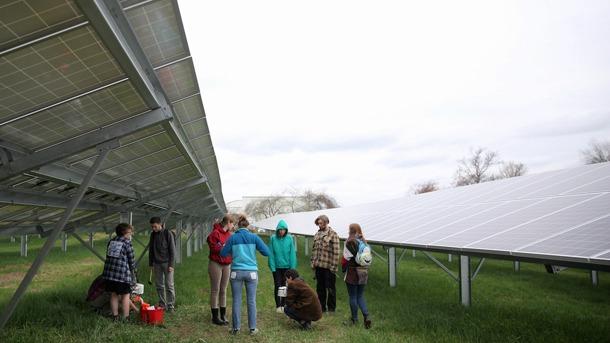Here comes the sun: How Hampshire College moved to 100 percent solar energy
Hampshire College is the first residential US college to go 100% solar for electricity. The 19-acre solar panel array was built on part of the campus’s open agricultural land.
Hampshire College, with about 1,400 students in Western Massachusetts, has become the first residential US college with 100 percent solar electricity.
Across the US, colleges and universities are among the institutions leading the fight against global warming, but Hampshire is the first residential campus in the US to go 100 percent solar.
“This is a great story that people don’t know about,” says Hampshire’s president, Jonathan Lash. “There are a lot of colleges and universities around the country who have decided to just get on with it. Some of their systems are bigger than ours. We’re pretty proud that we decided to go 100 percent and that we’re a small, not-very-well-resourced college out in snow country that’s able to do this.”
Hampshire was founded as a counterculture school in the 1960s, with a strong environmental focus. A few years ago, the college recruited Lash, the former head of World Resources Institute, to be its president. His tenure has seen the construction of everything from net zero energy buildings to the 19-acre solar power system.
The system consists of about 15,000 panels, which will produce 4.7 megawatts of power a year — more than the college uses annually. “We’re hooked up to the grid, so in the dark of night, in the middle of winter, there is still power flowing to all our students’ devices, but on a July day we’ll produce a lot more power than we’ll use,” Lash explains.
Hampshire students were deeply involved in selecting the sites for the panels, Lash says. Much of the college’s 800-plus acre campus is agricultural land that it mows for hay and uses to grow vegetables. The students chose to use open agricultural land in order to avoid cutting down trees and now a group of students are conducting research with one of their professors to determine whether installing solar collectors has any long-term impact on that land.
A committee of students, faculty and staff also worked with the college’s neighbors to be sure they took their concerns into account. As a result, the fields of panels are well screened from the road and from nearby homes. “It’s a big expanse of large, reflective panels,” Lash says. “If you look down on it from the air, it would attract your attention. If you look over at it from next door, you wouldn’t see it.”
Hampshire contracted with SolarCity (a company that is an underwriter of PRI’s Living on Earth) to install the panels. SolarCity owns and operates the panels, while Hampshire supplied the land and signed a contract to buy power from the panels. The solar power costs just over 5 cents a kilowatt hour, compared to more than 13 cents a kilowatt hour for power from the utility grid.
On winter evenings, the cost from the grid rises to over 30 cents a kilowatt hour, so Solar City also supplied the college with a bank of Tesla batteries that enables it to continue to draw on solar power generated and stored during sunnier days and hours. “That’s good for us and it’s actually helpful for the utility,” Lash notes.
Lash says when he first came to Hampshire, the school had already committed to reduce its greenhouse gas emissions. In 2012, they looked into installing solar power for the campus, but found it was too expensive. By 2015, Lash says, “the price had come down so much and the efficiency of the panels had gone up so much that we were able to move forward and have it be an overall savings, rather than an expense for the college.”
The school will save $8 to $10 million over the life of the solar system. But savings aside, Lash says, the most important aspect of the project for the school is its part in the curriculum.
“Students were involved in every part of the decision, from the research that determined that we were going to save money, to the choice of a contractor, to the selection of a site, working with neighbors, and now overseeing the management of the system,” Lash explains. “This is the challenge that our students — and every other student — are going to face in the next 20 years: How to turn the US economy into a low-carbon economy. They’re going to get the real first-hand experience of doing it.”
Ultimately, however, “it’s just the right thing to do in an era of accelerating climate change,” Lash says. “This keeps the jobs local. It means that there are no pipelines being built through people’s communities to get power to our college, and it helps, in the best way that we can, to avert climate change, the costs of which are falling most heavily on the poorest, most vulnerable people.”
This article is based on an interview that aired on PRI’s Living on Earth with Steve Curwood.
Our coverage reaches millions each week, but only a small fraction of listeners contribute to sustain our program. We still need 224 more people to donate $100 or $10/monthly to unlock our $67,000 match. Will you help us get there today?
